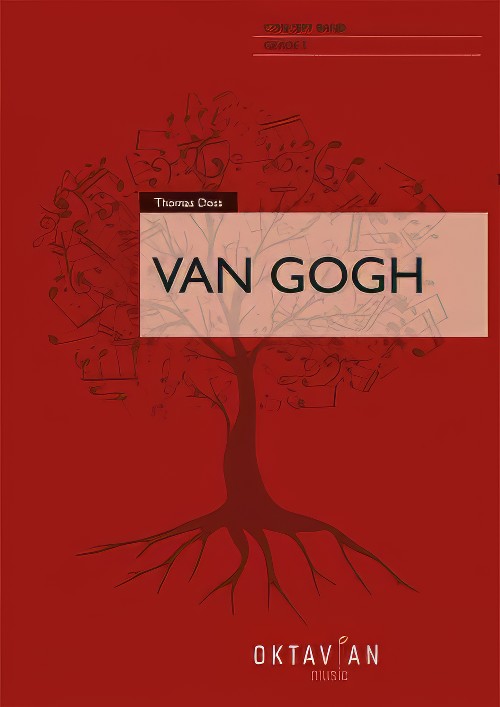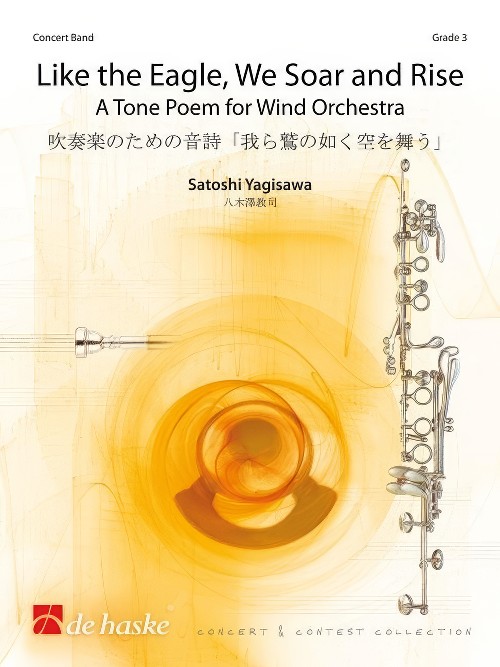Results
-
£40.50
Triumphal Overture - Anne McGinty
Based on a vigorous and persistent rhythmic motif, Triumphal Overture is written in three-part form, with energetic opening and closing sections separated by one in a more relaxed tempo. (4:45)
Estimated dispatch 7-14 working days
-
£95.95
Twist Of Fate - Larry Clark
Musical twists and turns abound in this compositional departure for composer Larry Clark. It contains all of his impeccable scoring and attention to detail, but is a refreshing change in sound and technique for this adept composer. The piece is at times energetic, and at other times, lyrical. Elusive and ever-changing in harmonic structure and rhythmic content, it all adds up to an exceptional new piece by one of the most popular composers of band music today.
Estimated dispatch 7-14 working days
-
£65.50
Star Journey - Alan Lee Silva
An energictic contest style piece that will have your students dreaming offeraveling to distance planets. You can hear the film music influence in this one by composer Alan Lee Silva. Get ready for blast-off!
Estimated dispatch 7-14 working days
-
 £179.99
£179.99Diagram - André Waignein
The story of the origin of Diagram for Symphonic Band is a curious one. Andr Waignein was enjoying a meal together with his great friend Jean-Marie Vivier - representative director of l'Oreal Belgilux and the same man who made the performance of the famous Cantate aux Etoiles, with 750 performers possible. Jean Plaquet, an appreciated associate of both gentlemen was also present.As an acknowledgement, Andr Waignein wanted to dedicate a composition to the band where Mr. Vivier has been chairman for 20 years. In connection with this, Andr Waignein was supposed to receive some extra information about the 120 years old history of this band, which has always been led by a memberof the Vivier family. In a flash this history was presented : using a diagram Mr. Vivier drew the power-lines of this more than 100 year old band.And of course, the title was found ! The only thing left to do, was for Andr Waignein to transform this diagram into music.
Estimated dispatch 7-14 working days
-
 £80.99
£80.99Defying Gravity - Steven Reineke
A programmatic composition that depicts the marvels of modern aviation. The opening represents the take-off and the majesty of the climb into the heavens. But after reaching cruising altitude and soaring peacefully above the clouds, the plane must descend through a strong turbulent storm. All ends well as the pilot regains control of the aircraft and heroically returns the band and your captivated audience safely to the ground. A superior choice for any festival or concert performance. Extraordinary music by one of today's most popular composers. VERY HIGHLY RECOMMENDED!!
Estimated dispatch 7-14 working days
-
£54.99
Shawnee Creek Legend - Ed Huckeby
An impressive overture by one of the most popular composers of music for young bands. Perfect as a concert or contest piece, it's fresh melodies and tasy scoring makes this a 'can't miss' anytime it is performed.
Estimated dispatch 7-14 working days
-
 £115.60
£115.60Jyn Erso Theme - Michael Giacchino
After seven soundtracks written by John Williams for the Star Wars. the music for Rogue One A Star Wars Story is composed by Michael Giacchino. Giacchino is one of the leading composers of film music today with soundtracks for "The Incredibles", "Star Trek", Zootropolis", "Inside Out", and TV-series "Lost" as his greatest achievements. With his music to "Rogue One", Giacchino puts his own mark on the new Star Wars movie but with natural influences by "the master" himself John Williams.. Jyn Erso Theme portraits one of the new characters of the "Rogue One" movie. British actress Felicity Jones plays the role of Jyn Erso in "Rogue One"
Estimated dispatch 7-14 working days
-
£149.99
Jello, The Colours Of My Soul - Ben Haemhouts
Jello...The Colours of my Soul is an assignment that was written to be a lasting memory of the untimely, dramatic death of a young child. The work came about due to various conversations between the father and the composer whereby the final resultmust be seen as an attempt by the composer to musically translate the feelings of the parents.The first part of the title, "Jello", is a combination of the names of the two children of the commissioner, namely Jelle and Lobcke, and "the Colours of mySoul" are the colours of the soul of the parents who despite the loss of one of their children, continue to cherish their two children. The introduction provides the atmosphere of grieving for the loss, whereby use is made of pure fifths in order toportray the solidarity with nature, as we are familiar with in symphonies by Bruckner. A little later a bit of the first theme is suggested, which develops into a real funeral march.The Dies Irae, as this occurs in Berlioz's Fantastic Symphony (F, E,F, D, E, C, D), forms a leitmotiv through the entire work in order to symbolise the constant battle between life and death.Shortly before the storm-passage, (where a wind machine is used) which announces disaster, fragments from children's songs areplayed to the accompaniment of a rising choir piece from behind the stage, which strengthens the imminent confrontation with death.After the introduction of the two themes in the long introduction, a quick passage follows in which all kinds ofbeautiful memories are recalled. There is story telling, laughing, and dancing. One of the previous children's songs is also cited. The Dies Irea is heard once again, this time short and fast.Bit by bit happy elements are steadily distorted untilseriousness breaks through again, like an unavoidable and unstoppable evil. The entire piece becomes evermore stirring, as if a big climax will follow. At this moment a very long fermata makes a sudden end to the hysterical allegro. The crucialmoment in the work follows...How does one deal with something as tragic as the death of one's own child? Does one mourn for what no longer is and what never will be? Or does one try to cherish the beautiful moments and continue to live with thesecolourful memories?A subdued, dignified choir piece captures the beautiful memories and ends in a positive, hopeful tone.
Estimated dispatch 7-14 working days
-
 £279.99
£279.99Van Gogh (Concert Band - Score and Parts) - Doss, Thomas
This composition is not a work inspired by the life of the famous painter, but rather an attempt at a pictorial immersion into his world. In addition to Van Gogh's character and tragic life, the technique he employed to create his works, the bright colours of his paintings and his view of nature served as inspiration for this musical work. Point by point, stroke by stroke, Van Gogh brought his own world to life on canvas.On the life of Van Gogh: The Dutch artist Vincent van Gogh was one of the most important pioneers of Modernism, despite being relatively unknown during his own lifetime. As an artist, he chose a life of poverty and seclusion. From today's perspective, his important woks were created from 1880 onwards, when he had already more or less succumbed to madness. While his earlier works could still be classed as contemporary, he matured into a pioneer of Expressionism with his later work indicating an increasing self-awareness. He was just 37 years old when he died but he created over 750 paintings and 1600 drawings in the last ten years of his life.The structure of the work:Start: Brushes and Paints: Van Gogh retired to Arles in southern France where he found his artistic home. The colours and flowering gardens of this landscape awakened in him an unbelievably great creative power.A: A Picture Comes into Being: Van Gogh's psychotic episodes and bouts of depression did not stop him from painting wonderful pictures. Hardly anyone recognised his genius during his lifetime, on the contrary, he often felt misunderstood.C: Paris - Arles: In Paris (from 1886), Van Gogh became inspired by the French art scene. His works found few takers, however. He met and befriended the painter Paul Gauguin, but the lack of success made Van Gogh short tempered, and he began to drink. Eventually, he moved from Paris to Arles in the south of France to establish an artists' collective with Gaugin. Within a few weeks, the two got into such a violent argument that Van Gogh attacked his friend with a knife. The friends parted ways and afterwards Van Gogh cut off his right ear. In 1889 he voluntarily admitted himself into a mental hospital at St. Remy, suffering from hallucinations and fearing that he would lose his mind.G: The Starry Night One of his most famous paintings, created in 1898.H: Death and Brotherly Love Vincent van Gogh accepted an invitation to Auver-sur-Oise in 1890. This was one of his most intensive creative periods. He also went there for treatment, but his mental state hardly improved. After an extended walk, he injured himself fatally with a pistol under mysterious circumstances. Not even to his beloved brother Theo, who had supported him all his life, did he reveal on his deathbed how the accident had occurred.J: Art Market Today, Van Gogh's paintings are among the most expensive paintings on the art market. How ironic, given that he could hardly sell a painting during his lifetime. "I put my heart and soul into my work and lost my mind in the process." (Vincent van Gogh)Duration: 13.15
Estimated dispatch 7-14 working days
-
 £144.99
£144.99Like the Eagle, We Soar and Rise (Concert Band - Score and Parts) - Yagisawa, Satoshi
Like the Eagle, We Soar and Rise was commissioned by Yuying Secondary School Concert Band and Yuying Alumni Association for the 2010 centenary of the school's foundation. The piece was named by a friend of the composer named Steven Phua, who originally suggested commissioning a new piece to Satoshi Yagisawa. The piece furthermore takes its name from the text of the Yuying Secondary School song.This composition is based on three different concepts: the first one demonstrates 'The founders' passion for education'; the second concept illustrates 'Hardship in war time'; the third one 'To the future' describes the inner strength people find to overcome struggles. This piece concludes with a fanfare, which is the sound of hope that leads to a brighter future in a positive direction.The world premiere of this piece was conducted by Faizal Bin Othman, who is one of the leading educators in Singapore, and was performed by the Yuying Secondary School Concert Band.Duration: 8.00
Estimated dispatch 7-14 working days
